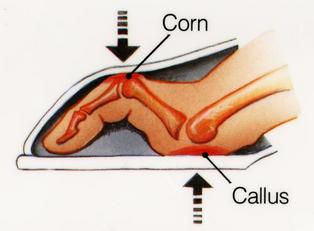Hammertoe
What is Hammertoe?
Hammertoe is a bending of one or both joints of the toes. This abnormal bending can put pressure on the toe when wearing shoes, causing problems to develop.
Hammertoes usually start out as mild deformities and get progressively worse over time. In the earlier stages, hammertoes are flexible, and the symptoms can often be managed with non-invasive measures. But if left untreated, hammertoes can become more rigid and will not respond to non-surgical treatment.

Causes
The most common cause of hammertoe is a muscle/tendon imbalance. This imbalance, which leads to a bending of the toe, results from structural changes in the foot that occur over time in some people.
Hammertoes may be aggravated by shoes that don’t fit properly. A hammertoe may result if a toe is too long and is forced into a cramped position when a tight shoe is worn.
Occasionally, hammertoe is the result of an earlier trauma to the toe. In some people, hammertoes are inherited.
Symptoms
Common symptoms of hammertoes include:
- Pain when wearing shoes.
- Corns and calluses on the toe, between two toes, or on the ball of the foot.
- Inflammation.
- Contracture of the toe.
In more severe cases of hammertoe, open sores may form.
Diagnosis
Although hammertoes are readily apparent, to arrive at a diagnosis the foot and ankle surgeon will obtain a thorough history of your symptoms and examine your foot. During the physical examination, the doctor may attempt to reproduce your symptoms by manipulating your foot and will study the contractures of the toes. In addition, the foot and ankle surgeon may take x-rays to determine the degree of the deformities and assess any changes that may have occurred.
Hammertoes are progressive – they don’t go away by themselves and usually they will get worse over time.
Non-surgical Treatment
A number of non-surgical measures can be undertaken:
- Padding corns and calluses.
- Changes in shoe wear.
- Orthotic devices. A custom orthotic device placed in your shoe may help control the muscle/tendon imbalance.
- Injection therapy. Corticosteroid injections are sometimes used to ease pain and inflammation caused by hammertoe.
- Medications.
- Splinting/strapping.
When is Surgery Needed?
Although hammertoes are readily apparent, to arrive at a diagnosis the foot and ankle surgeon will obtain a thorough history of your symptoms and examine your foot. During the physical examination, the doctor may attempt to reproduce your symptoms by manipulating your foot and will study the contractures of the toes. In addition, the foot and ankle surgeon may take x-rays to determine the degree of the deformities and assess any changes that may have occurred.
Hammertoes are progressive – they don’t go away by themselves and usually they will get worse over time.
Complete and comprehensive spectrum of both diagnosis and treatments
QUICK LINKS
ABOUT
Specialist Foot and Ankle Surgery and Consultation in Manchester. Our specialist team of surgeons and podiatrists provide the highest level of expertise in the effective management of any foot and ankle condition. .
Manchester Foot And Ankle Clinic / North West OrthoSports is a Registered Trade Mark
North West OrthoSports / Manchester Foot & Ankle Clinic Ltd
93-107 . Lancefield Steet
Glasgow .G3 8HZ
Limited Company-387376
VAT Registration - 214 0705 54
Please See Our Legal Disclaimer on Online Medical Advice
All Rights Reserved | Manchester Foot And Ankle Clinic | Privacy Policy


